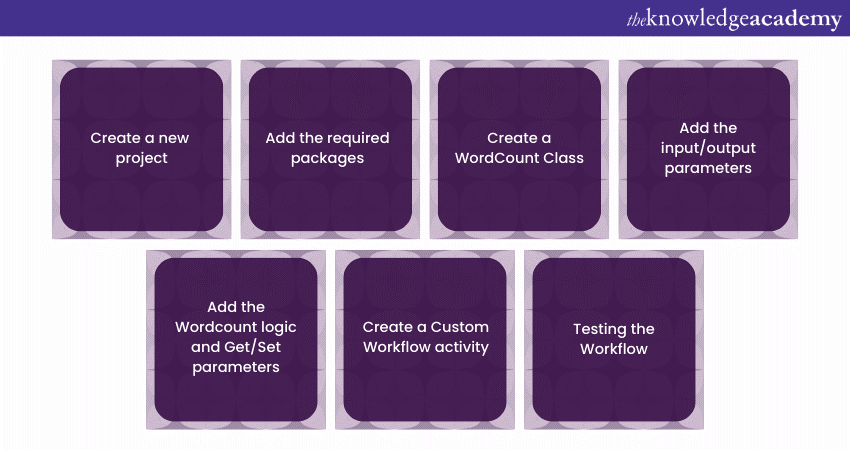We may not have the course you’re looking for. If you enquire or give us a call on 01344203999 and speak to our training experts, we may still be able to help with your training requirements.
Training Outcomes Within Your Budget!
We ensure quality, budget-alignment, and timely delivery by our expert instructors.

The power of Custom Workflow in Dynamics 365 comes into play to fulfil the need for flexibility and customisation. This feature enables organisations to tailor their automated processes to meet specific operational requirements, enhancing efficiency and ensuring compliance.
Custom Workflows can automate complex tasks, integrate seamlessly with other Microsoft services, and offer a personalised touch that general Workflows may lack. In this blog, you will learn about Custom Workflow in Dynamics 365 and how to design one with a step-by-step procedure, including testing the Custom Workflow. Read to learn more!
Table of Contents
1) Understanding What is Custom Workflow in Dynamics 365
2) Steps to create a Custom Workflow in Dynamics 365
a) Create a new project
b) Add the required packages
c) Create a WordCount class
d) Add the input/output parameters
e) Add the Wordcount logic and Get/Set parameters
f) Signing the assembly
g) Register the assembly in Dynamics 365
h) Create a Custom Workflow activity
I) Testing the Workflow
3) Conclusion
Understanding What is Custom Workflow in Dynamics 365
Custom Workflow in Dynamics 365 refers to a tailored set of automated actions, decisions, and tasks designed to streamline and manage specific business processes within the platform. Unlike built-in Workflows that come pre-configured to handle general business needs, Custom Workflows allow organisations to create bespoke solutions suited to their unique operational requirements.
Additionally, this customisation is beneficial for companies with specialised needs that are not adequately addressed by Dynamics 365's out-of-the-box features. Businesses can use the platform’s Workflow engine to define rules, set conditions, and trigger actions based on various events or changes in data.
For example, a Custom Workflow could be created to automate a multi-step approval process for expense reports, sending notifications to different departments and even integrating with other Microsoft services like Office 365 for document storage or Power BI for data analysis.
Moreover, the objective of a Custom Workflow is to increase efficiency, reduce manual intervention, and ensure compliance with industry-specific regulations. This enables a more focused approach to process management, allowing businesses to extract maximum value from their Dynamics 365 investment. In summary, Custom Workflows in Dynamics 365 offer a powerful means to tailor the platform's capabilities to fit the individual needs and complexities of a business precisely.
Steps to create a Custom Workflow in Dynamics 365
Now, let's see the steps to create a Custom Workflow in Dynamics 365:

Create a new project
These are the steps to create a new project in Dynamics 365:
a) Login to Dynamics 365: Open your browser, navigate to the Dynamics 365 portal, and log in with your credentials.
b) Navigate to Project Service: Find and click on the "Project Service" module from the main dashboard.
c) Create new project: Click on the "New" button usually located at the top of the screen to initiate a new project.
d) Input details: Fill in essential project information such as the project name, client, start and end dates, and budget.
e) Assign resources: Select team members and allocate resources by choosing from available options.
f) Save and validate: Click the "Save" button and validate the project to ensure all required fields are correctly filled out.
g) Activate project: Finally, activate the project to set it in motion, making it accessible to team members for updates and tracking.
Add the required packages
These are the steps to add the required packages in Dynamics 365:
a) Go to the project workspace: After creating a new project, navigate to the specific project workspace within Dynamics 365.
b) Find Package Management: Locate the "Package Management" or "Add-ons" tab, often found in the sidebar or under project settings.
c) Browse packages: Scroll through available packages or use the search function to find the ones you need.
d) Select and install: Choose the required packages and click on the "Install" or "Add" button to include them in your project.
e) Review dependencies: Check for any package dependencies that may also need to be installed.
f) Confirm installation: A prompt may appear for confirmation; click "OK" or "Confirm" to proceed.
g) Test functionality: Once installed, test the packages to ensure they work as intended within your project environment.
h) Save changes: Always remember to save any changes made to the project to secure the newly added packages.
Enhance your customer engagement capabilities, by signing up for our Microsoft Dynamic 365 Fundamentals (CRM) MB910 course now!
Create a WordCount Class
These are the steps to create a WordCount Class in Dynamics 365:
a) Open development environment: Navigate to the development or code interface within your Dynamics 365 project.
b) New class: Create a new class and name it "Wordcount."
c) Import packages: Use import statements to include the packages you've just added, if needed.
d) Add code: Write your code logic for counting words within the class.
e) Save and test: Save your changes and run tests to ensure the Wordcount class functions as expected.
Add the input/output parameters
These are the steps to add the input/output parameters in Dynamics 365:
a) Locate class or Workflow: In Dynamics 365, find the class or Workflow where you want to add input/output parameters.
b) Edit mode: Enter edit mode to modify the configuration.
c) Add parameters: Locate the "Parameters" section and add the desired input/output fields.
d) Specify types: Define the data types for each parameter, such as string, integer, or boolean.
e) Save and validate: Save your changes and validate to ensure the parameters are correctly configured.
Add the Wordcount logic and Get/Set parameters
These are the steps to add the Wordcount logic and Get/Set parameters in Dynamics 365:
a) Access Wordcount class: Navigate to your previously created Wordcount Class within the Dynamics 365 development environment.
b) Insert logic: Add your word-counting logic using appropriate methods and algorithms.
c) Define Get/Set methods: Create getter and setter methods to manage data flow for input/output parameters.
d) Link parameters: Connect the Get/Set methods to your word count logic to handle input and output.
e) Save & test: Save all modifications and execute test runs to validate that the logic and parameter methods work as intended.
Create a Custom Workflow activity
These are the steps to create a Custom Workflow activity in Dynamics 365:
a) Navigate to settings: In Dynamics 365, go to the 'Settings' tab and select 'Processes.'
b) New Workflow: Click on 'New' to start a Custom Workflow and choose the entity it will relate to.
c) Configure conditions: Add Workflow steps, conditions, and actions to automate your process.
d) Save & test: Save your Workflow settings and run test scenarios to ensure it's functioning correctly.
e) Activate Workflow: Once testing is satisfactory, activate the Custom Workflow to implement it across your organisation.
Track your data against sales goals, by signing up for our Microsoft Dynamics 365 Sales MB210 now!
Testing the Workflow
These are the steps to test the Workflow in Dynamics 365:
a) Navigate to Workflow: In Dynamics 365, go to 'Settings' and then 'Processes' to find your Custom Workflow.
b) Run manually: Choose the option to run the Workflow manually on sample data or trigger the conditions that initiate it.
c) Monitor logs: Check the Workflow logs for successful execution or any errors.
d) Validate results: Confirm that the intended actions, such as data updates or notifications, have occurred.
e) Adjust & retest: If necessary, adjust the Workflow configuration and retest to ensure accuracy.
Conclusion
Mastering creating and testing a Custom Workflow in Dynamics 365 can significantly boost your organisation's efficiency and adaptability. By tailoring processes to meet your unique needs, you unlock the platform's full potential, enabling seamless operations and improved business outcomes.
Learn to organise your sales and marketing operations, by signing up for our Microsoft Dynamics 365 Training now!
Frequently Asked Questions
Upcoming Microsoft Technical Resources Batches & Dates
Date
 Microsoft Dynamics 365 Fundamentals (CRM) MB910
Microsoft Dynamics 365 Fundamentals (CRM) MB910
Fri 24th May 2024
Fri 30th Aug 2024
Fri 20th Dec 2024







 Top Rated Course
Top Rated Course



 If you wish to make any changes to your course, please
If you wish to make any changes to your course, please


